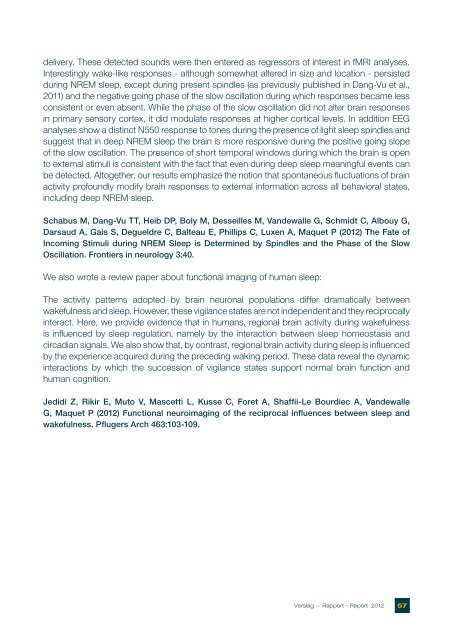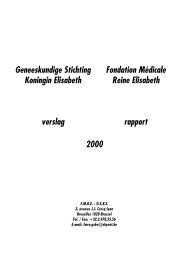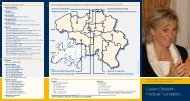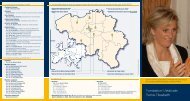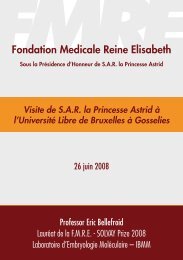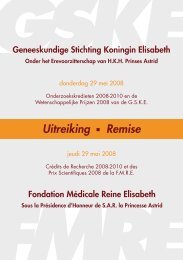Verslag – Rapport – Bericht – Report - GSKE - FMRE
Verslag – Rapport – Bericht – Report - GSKE - FMRE
Verslag – Rapport – Bericht – Report - GSKE - FMRE
Create successful ePaper yourself
Turn your PDF publications into a flip-book with our unique Google optimized e-Paper software.
delivery. These detected sounds were then entered as regressors of interest in fMRI analyses.<br />
Interestingly wake-like responses - although somewhat altered in size and location - persisted<br />
during NREM sleep, except during present spindles (as previously published in Dang-Vu et al.,<br />
2011) and the negative going phase of the slow oscillation during which responses became less<br />
consistent or even absent. While the phase of the slow oscillation did not alter brain responses<br />
in primary sensory cortex, it did modulate responses at higher cortical levels. In addition EEG<br />
analyses show a distinct N550 response to tones during the presence of light sleep spindles and<br />
suggest that in deep NREM sleep the brain is more responsive during the positive going slope<br />
of the slow oscillation. The presence of short temporal windows during which the brain is open<br />
to external stimuli is consistent with the fact that even during deep sleep meaningful events can<br />
be detected. Altogether, our results emphasize the notion that spontaneous fluctuations of brain<br />
activity profoundly modify brain responses to external information across all behavioral states,<br />
including deep NREM sleep.<br />
Schabus M, Dang-Vu TT, Heib DP, Boly M, Desseilles M, Vandewalle G, Schmidt C, Albouy G,<br />
Darsaud A, Gais S, Degueldre C, Balteau E, Phillips C, Luxen A, Maquet P (2012) The Fate of<br />
Incoming Stimuli during NREM Sleep is Determined by Spindles and the Phase of the Slow<br />
Oscillation. Frontiers in neurology 3:40.<br />
We also wrote a review paper about functional imaging of human sleep:<br />
The activity patterns adopted by brain neuronal populations differ dramatically between<br />
wakefulness and sleep. However, these vigilance states are not independent and they reciprocally<br />
interact. Here, we provide evidence that in humans, regional brain activity during wakefulness<br />
is influenced by sleep regulation, namely by the interaction between sleep homeostasis and<br />
circadian signals. We also show that, by contrast, regional brain activity during sleep is influenced<br />
by the experience acquired during the preceding waking period. These data reveal the dynamic<br />
interactions by which the succession of vigilance states support normal brain function and<br />
human cognition.<br />
Jedidi Z, Rikir E, Muto V, Mascetti L, Kusse C, Foret A, Shaffii-Le Bourdiec A, Vandewalle<br />
G, Maquet P (2012) Functional neuroimaging of the reciprocal influences between sleep and<br />
wakefulness. Pflugers Arch 463:103-109.<br />
<strong>Verslag</strong> <strong>–</strong> <strong>Rapport</strong> <strong>–</strong> <strong>Report</strong> 2012 57


